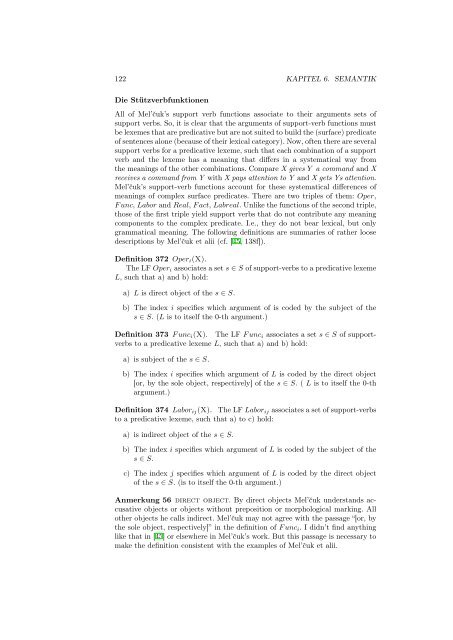Einführung in die Linguistik
Create successful ePaper yourself
Turn your PDF publications into a flip-book with our unique Google optimized e-Paper software.
122 KAPITEL 6. SEMANTIK<br />
Die Stützverbfunktionen<br />
All of Mel’čuk’s support verb functions associate to their arguments sets of<br />
support verbs. So, it is clear that the arguments of support-verb functions must<br />
be lexemes that are predicative but are not suited to build the (surface) predicate<br />
of sentences alone (because of their lexical category). Now, often there are several<br />
support verbs for a predicative lexeme, such that each comb<strong>in</strong>ation of a support<br />
verb and the lexeme has a mean<strong>in</strong>g that differs <strong>in</strong> a systematical way from<br />
the mean<strong>in</strong>gs of the other comb<strong>in</strong>ations. Compare X gives Y a command and X<br />
receives a command from Y with X pays attention to Y and X gets Ys attention.<br />
Mel’čuk’s support-verb functions account for these systematical differences of<br />
mean<strong>in</strong>gs of complex surface predicates. There are two triples of them: Oper,<br />
F unc, Labor and Real, F act, Labreal. Unlike the functions of the second triple,<br />
those of the first triple yield support verbs that do not contribute any mean<strong>in</strong>g<br />
components to the complex predicate. I.e., they do not bear lexical, but only<br />
grammatical mean<strong>in</strong>g. The follow<strong>in</strong>g def<strong>in</strong>itions are summaries of rather loose<br />
descriptions by Mel’čuk et alii (cf. [45, 138f]).<br />
Def<strong>in</strong>ition 372 Oper i (X).<br />
The LF Oper i associates a set s ∈ S of support-verbs to a predicative lexeme<br />
L, such that a) and b) hold:<br />
a) L is direct object of the s ∈ S.<br />
b) The <strong>in</strong>dex i specifies which argument of is coded by the subject of the<br />
s ∈ S. (L is to itself the 0-th argument.)<br />
Def<strong>in</strong>ition 373 F unc i (X). The LF F unc i associates a set s ∈ S of supportverbs<br />
to a predicative lexeme L, such that a) and b) hold:<br />
a) is subject of the s ∈ S.<br />
b) The <strong>in</strong>dex i specifies which argument of L is coded by the direct object<br />
[or, by the sole object, respectively] of the s ∈ S. ( L is to itself the 0-th<br />
argument.)<br />
Def<strong>in</strong>ition 374 Labor ij (X). The LF Labor ij associates a set of support-verbs<br />
to a predicative lexeme, such that a) to c) hold:<br />
a) is <strong>in</strong>direct object of the s ∈ S.<br />
b) The <strong>in</strong>dex i specifies which argument of L is coded by the subject of the<br />
s ∈ S.<br />
c) The <strong>in</strong>dex j specifies which argument of L is coded by the direct object<br />
of the s ∈ S. (is to itself the 0-th argument.)<br />
Anmerkung 56 direct object. By direct objects Mel’čuk understands accusative<br />
objects or objects without preposition or morphological mark<strong>in</strong>g. All<br />
other objects he calls <strong>in</strong>direct. Mel’čuk may not agree with the passage “[or, by<br />
the sole object, respectively]” <strong>in</strong> the def<strong>in</strong>ition of F unc i . I didn’t f<strong>in</strong>d anyth<strong>in</strong>g<br />
like that <strong>in</strong> [45] or elsewhere <strong>in</strong> Mel’čuk’s work. But this passage is necessary to<br />
make the def<strong>in</strong>ition consistent with the examples of Mel’čuk et alii.



